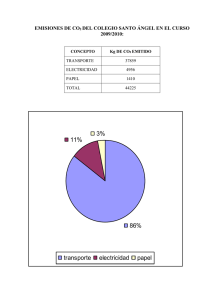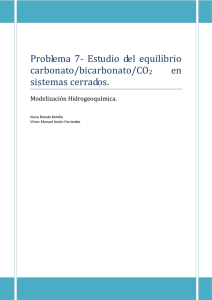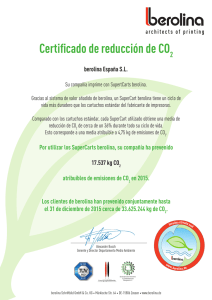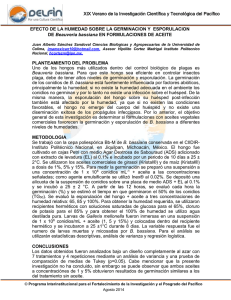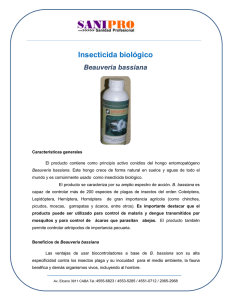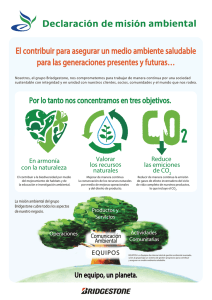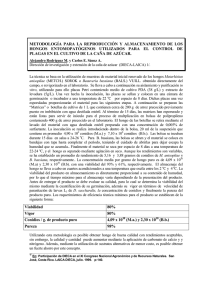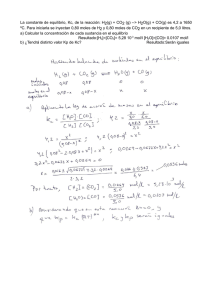PERFILES DIFERENCIALES DE Beauveria bassiana (Bals.
Anuncio
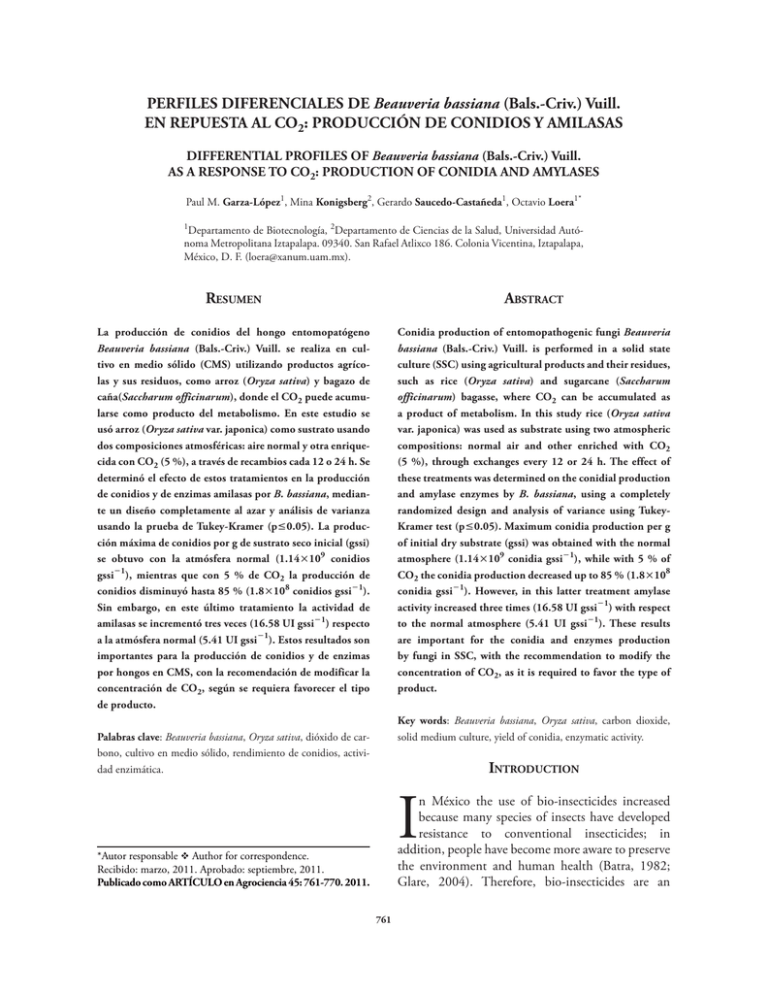
PERFILES DIFERENCIALES DE Beauveria bassiana (Bals.-Criv.) Vuill. EN REPUESTA AL CO2: PRODUCCIÓN DE CONIDIOS Y AMILASAS DIFFERENTIAL PROFILES OF Beauveria bassiana (Bals.-Criv.) Vuill. AS A RESPONSE TO CO2: PRODUCTION OF CONIDIA AND AMYLASES Paul M. Garza-López1, Mina Konigsberg2, Gerardo Saucedo-Castañeda1, Octavio Loera1* Departamento de Biotecnología, 2Departamento de Ciencias de la Salud, Universidad Autónoma Metropolitana Iztapalapa. 09340. San Rafael Atlixco 186. Colonia Vicentina, Iztapalapa, México, D. F. ([email protected]). 1 Resumen Abstract La producción de conidios del hongo entomopatógeno Beauveria bassiana (Bals.-Criv.) Vuill. se realiza en cultivo en medio sólido (CMS) utilizando productos agrícolas y sus residuos, como arroz (Oryza sativa) y bagazo de caña(Saccharum officinarum), donde el CO2 puede acumularse como producto del metabolismo. En este estudio se usó arroz (Oryza sativa var. japonica) como sustrato usando dos composiciones atmosféricas: aire normal y otra enriquecida con CO2 (5 %), a través de recambios cada 12 o 24 h. Se determinó el efecto de estos tratamientos en la producción de conidios y de enzimas amilasas por B. bassiana, mediante un diseño completamente al azar y análisis de varianza usando la prueba de Tukey-Kramer (p0.05). La producción máxima de conidios por g de sustrato seco inicial (gssi) se obtuvo con la atmósfera normal (1.14109 conidios gssi1), mientras que con 5 % de CO2 la producción de conidios disminuyó hasta 85 % (1.8108 conidios gssi1). Sin embargo, en este último tratamiento la actividad de amilasas se incrementó tres veces (16.58 UI gssi1) respecto a la atmósfera normal (5.41 UI gssi1). Estos resultados son importantes para la producción de conidios y de enzimas por hongos en CMS, con la recomendación de modificar la concentración de CO2, según se requiera favorecer el tipo de producto. Conidia production of entomopathogenic fungi Beauveria bassiana (Bals.-Criv.) Vuill. is performed in a solid state culture (SSC) using agricultural products and their residues, such as rice (Oryza sativa) and sugarcane (Saccharum officinarum) bagasse, where CO2 can be accumulated as a product of metabolism. In this study rice (Oryza sativa var. japonica) was used as substrate using two atmospheric compositions: normal air and other enriched with CO2 (5 %), through exchanges every 12 or 24 h. The effect of these treatments was determined on the conidial production and amylase enzymes by B. bassiana, using a completely randomized design and analysis of variance using TukeyKramer test (p0.05). Maximum conidia production per g of initial dry substrate (gssi) was obtained with the normal atmosphere (1.14109 conidia gssi1), while with 5 % of CO2 the conidia production decreased up to 85 % (1.8108 conidia gssi1). However, in this latter treatment amylase activity increased three times (16.58 UI gssi1) with respect to the normal atmosphere (5.41 UI gssi1). These results are important for the conidia and enzymes production by fungi in SSC, with the recommendation to modify the concentration of CO2, as it is required to favor the type of product. Key words: Beauveria bassiana, Oryza sativa, carbon dioxide, solid medium culture, yield of conidia, enzymatic activity. Palabras clave: Beauveria bassiana, Oryza sativa, dióxido de carbono, cultivo en medio sólido, rendimiento de conidios, actividad enzimática. Introduction I n México the use of bio-insecticides increased because many species of insects have developed resistance to conventional insecticides; in addition, people have become more aware to preserve the environment and human health (Batra, 1982; Glare, 2004). Therefore, bio-insecticides are an *Autor responsable v Author for correspondence. Recibido: marzo, 2011. Aprobado: septiembre, 2011. Publicado como ARTÍCULO en Agrociencia 45: 761-770. 2011. 761 AGROCIENCIA, 1 de octubre - 15 de noviembre, 2011 Introducción E n México aumenta el uso de bioinsecticidas debido a que muchas especies de insectos han desarrollado resistencia a insecticidas convencionales; además, el público ha adquirido más consciencia de preservar el ambiente y la salud humana (Batra, 1982; Glare, 2004). Por ello, los bioinsecticidas son una alternativa en la agricultura sostenible y manejo integral de plagas (Lacey y Goettel, 1995). Existen alrededor de 2000 especies de microorganismos entomopatógenos, de los cuales 750 son especies de hongos (Candas y Bulla, 2002). La mayoría de estos microorganismos infectan únicamente a insectos y no son nocivos para otros organismos como aves, mamíferos o plantas (Alatorre-Rosas, 2007). Dentro de las especies de hongos usadas para formular bioinsecticidas se encuentra Beauveria bassiana (Bals.-Criv.) Vuill., la cual infecta a varias especies de insectos plaga como picudo del algodonero (Anthonomus grandis), palomilla de la manzana (Cydia pomonella), barrenador del tallo de maíz (Diatraea saccharalis), gusano de la harina (Tenebrio molitor), broca del café (Hypothenemus hampei) y mosquitas blancas (Bemisia spp.) (Hernández-Velázquez y Berlanga-Padilla, 1999; Alves et al., 2002; De la Rosa et al., 2002; Montesinos-Matías et al., 2011). La producción de conidios de B. bassiana se realiza en cultivo en medio sólido (CMS) y en cultivo líquido (CL). Para el CMS se usan soportes naturales como bagazo de caña (Saccharum officinarum), residuos de papa (Solanum tuberosum), salvado de trigo (Triticum aestivum) y arroz (Oryza sativa) (Neves y Alves, 2000; Dalla-Santa et al., 2004, 2005; NúñezGaona et al., 2010). Ye et al. (2006) desarrollaron una cámara de cultivo para producir conidios de B. bassiana a nivel de planta piloto, utilizando arroz como sustrato. Además de este sistema, hay procesos de producción de conidios de B. bassiana basados en paja de arroz y salvado de trigo (Kang et al., 2005). En otros estudios donde se usó arroz como sustrato para la producción de Metarhizium anisopliae y B. bassiana (Liu y Tzeng, 1999; Neves y Alves, 2000; Arzumanov et al., 2005). Sin embargo, no se ha considerado medir la actividad de amilasas, que son las enzimas más importantes para hidrolizar el almidón, el cual es la fuente de carbono más importante en el arroz. Por tanto, hay varios productos agrícolas y 762 VOLUMEN 45, NÚMERO 7 option for sustainable agriculture and integral pest management (Lacey and Goettel, 1995). There are about 2000 species of entomopathogenic microorganisms, of which 750 are species of fungi (Candas and Bulla, 2002). Most of these microorganisms infect only insects and are innocuous for other organisms as birds, mammals or plants (Alatorre-Rosas, 2007). Among the species of fungi used to formulate bio-insecticides are Beauveria bassiana (Bals.-Criv.) Vuill., which infects several species of pest insects, such as boll weevil (Anthonomus grandis), codling moth (Cydia pomonella ), corn stalk borer (Diatraea saccharalis), mealworm (Tenebrio molitor), coffee berry borer (Hypothenemus hampei) and whiteflies (Bemisia spp.) (Hernández-Velázquez and Berlanga-Padilla, 1999; Alves et al., 2002; De la Rosa et al., 2002; Montesinos-Matías et al., 2011). The production of conidia of B. bassiana is usually achieved in solid culture (SSC) and in liquid culture (LC). For the SSC natural supports are used such as sugar cane (Saccharum officinarum) bagasse, potato (Solanum tuberosum) residues, wheat (Triticum aestivum) bran and rice (Oryza sativa) (Neves and Alves, 2000; Dalla-Santa et al., 2004, 2005; NuñézGaona et al., 2010). Ye et al. (2006) developed a culture chamber to produce conidia of B. bassiana at pilot plant level, using rice as substrate. In addition to this system, there are processes of production of conidia of B. bassiana based on rice straw and wheat bran (Kang et al., 2005). In other studies was used as a substrate for the production of Metarhizium anisopliae and B. bassiana (Liu and Tzeng, 1999; Neves and Alves, 2000; Arzumanov et al., 2005). However, it has not been considered to measure the amylases activity, which are the most important enzymes to hydrolyze starch, that is the most important carbon source in rice. Therefore, there are several agricultural products and agro-industrial residues used in the world to produce conidia of this entomopathogenic fungus, which are the most important infective units for field application. Some factors have an important influence on the production of conidia such as heat transfer, size and type of substrate particles, water activity, pH, temperature and gas exchange (Saucedo-Castañeda et al., 1990; Alatorre-Rosas, 2007; Núñez-Gaona et al., 2010). In the processes of conidia production, CO2 can be accumulated in the reactors, as a product PERFILES DIFERENCIALES DE Beauveria bassiana (Bals.-Criv.) Vuill. EN REPUESTA AL CO2: PRODUCCIÓN DE CONIDIOS Y AMILASAS residuos agroindustriales usados en el mundo para producir conidios de este hongo entomopatógeno, los cuales son las unidades infectivas más importantes para la aplicación en campo. Algunos factores tienen una influencia importante en la producción de conidios: transferencia de calor, tamaño y tipo de partícula del sustrato, actividad de agua, pH, temperatura e intercambio gaseoso (Saucedo-Castañeda et al., 1990; AlatorreRosas, 2007; Núñez-Gaona et al., 2010). En los procesos de producción de conidios se puede acumular el CO2 en los reactores, como producto del metabolismo del propio hongo. El efecto de la concentración de CO2 se ha descrito para varias especies de hongos filamentosos en CMS y en CL (Desgranges y Durand, 1990; McIntyre y McNeil, 1998). Lord (2009) realizó un estudio con una atmósfera con baja concentración de O2 y elevada cantidad de CO2, pero sólo durante los bioensayos con insectos infectados con B. bassiana. El objetivo de este estudio fue comparar el efecto de dos composiciones atmosféricas, una normal (aire) y otra con 5 % de CO2, durante el crecimiento, producción de conidios y amilasas de B. bassiana utilizando un soporte natural fácilmente manipulable como el arroz. Materiales y Métodos Se utilizó la cepa de B. bassiana Bb 882.5 perteneciente a la colección de la Universidad Autónoma MetropolitanaIztapalapa (México, D. F.), propagada por picadura en matraces Erlenmeyer de 250 mL conteniendo 50 mL de agar Sabouraud-Maltosa al 2 % modificado (SMA) (agar 15 g L1, maltosa 20 g L1, peptona de caseína 2.5 g L1, extracto de levadura 0.5 g L1 y avena molida 15 g L1), esterilizados 15 min en autoclave a 15 PSI. Una vez inoculados, se incubaron 8 d a 281 °C con un fotoperiodo 12:12 h. Cultivo en medio sólido Como unidades experimentales se usaron botellas serológicas de 75 mL conteniendo 5 g de arroz pre-cocido, esterilizadas 15 min en autoclave a 15 PSI. Se preparó una suspensión de conidios adicionando 20 mL de una solución estéril de Tween 80 al 0.05 % a los matraces Erlenmeyer usados en la propagación. Luego se contaron conidios en cámara de Neubauer, realizando las diluciones necesarias, con Tween 80 al 0.05 %, para obtener una concentración de 5106 conidios por mL (con mL1). of metabolism of the fungus itself. The effect of CO2 concentration has been described for several species of filamentous fungi in SSC and in LC (Desgranges and Durand, 1990; McIntyre and McNeil, 1998). Lord (2009) conducted a study under an atmosphere with a low concentration of O2 and a high amount of CO2, but only during bioassays with insects infected with B. bassiana. The aim of this study was to compare the effect of two atmospheric conditions, normal (air) and other with (5 %) of CO2, during growth, conidia and amylases production of B. bassiana using an easily manipulated natural support such as rice. Materials and Methods The strain of B. bassiana Bb 882.5 which belongs to the culture collection of the Universidad Autónoma MetropolitanaIztapalapa (México City) was used, propagated by point inoculation in Erlenmeyer flasks of 250 mL containing 50 mL of Sabouraud-Maltose agar at 2 % modified (SMA) (agar 15 g L1, maltose 20 g L1, casein peptone 2.5 g L1, yeast extract 0.5 g L1, and ground oats 15g L1), sterilized 15 min in an autoclave at 15 PSI. Once inoculated, were incubated 8 d at 281 °C with a 12:12 h photoperiod. Culture in solid medium Serological bottles of 75 mL were used as experimental units, containing 5 g of pre-cooked rice, sterilized 15 min in an autoclave at 15 PSI. A suspension of conidia was prepared adding 20 mL of a sterile Tween 80 solution at 0.05 % to the Erlenmeyer flasks used in the propagation. Conidia were then counted in the Neubauer chamber, making the necessary dilutions with Tween 80 at 0.05 %, to obtain a concentration of 5106 conidia per mL (con mL1). Finally 1 mL was added of this suspension of conidia to obtain a final concentration of 1106 conidia per g of initial solid substrate (con gssi1), with the necessary amount of a sterile solution of yeast extract (0.5 g L1) to obtain 40 % of initial moisture content. Modification of the atmosphere Two gas mixtures were utilized; normal atmosphere (21 % O2) and one enriched with CO2 (21 % O2 and 5% CO2). The enriched mixture was purchased from the company PraxairMexico S. A. All experiments began with a pre-stationary phase, where for each experimental unit a cotton plug was placed. On the third day of the culture rubber seals were placed to the GARZA-LÓPEZ et al. 763 AGROCIENCIA, 1 de octubre - 15 de noviembre, 2011 Finalmente se adicionó 1 mL de esta suspensión de conidios para obtener una concentración final de 1106 conidios por g de sustrato sólido inicial (con gssi1), con la cantidad necesaria de una solución estéril de extracto de levadura (0.5 g L1) para obtener humedad inicial de 40 %. Modificación de la atmósfera Se utilizaron dos mezclas gaseosas: atmósfera normal (21 % O2) y una enriquecida con CO2 (21 % O2 y 5 % CO2). La mezcla enriquecida se adquirió de la compañía PraxairMéxico S. A. Todos los experimentos comenzaron con una fase pre-estacionaria, donde a cada unidad experimental se colocó un tapón de algodón. Al tercer día del cultivo se colocaron tapones de goma a las botellas destinadas al tratamiento enriquecido con CO2 y se colocaron dos agujas, una para facilitar la salida de los gases y la segunda conectada al tanque que contenía la mezcla enriquecida con flujo de 20 cm3 s1 por 1 min (Tlecuitl-Beristain et al., 2010). Los recambios gaseosos se realizaron a intervalos de 12 o de 24 h para determinar si existía un efecto por la frecuencia del recambio. El cultivo se incubó 8 d a 281 °C con un fotoperiodo 12:12 h, con tres repeticiones en cada tiempo de muestreo. La atmósfera normal se nombró AN, mientras que la mezcla enriquecida con CO2 se denominó 21-5. Producción de conidios y medición de pH Los conteos de conidios se hicieron tomando muestras de las botellas serológicas. Para ello, se adicionaron 20 mL de Tween 80 al 0.05 %, se agitaron 10 min y se contaron conidios en cámara de Neubauer. La suspensión de biomasa (conidios y micelio) restante se vertió en tubos Falcon de 50 mL para determinar los valores de pH con un potenciómetro Conductronic™ pH 120. La producción de conidios se reporta por g de sustrato seco inicial (gssi). Determinación de proteína extracelular Se utilizó el método de Bradford (1976) con una curva estándar de seroalbúmina bovina y se leyó la absorbancia a 595 nm en espectrofotómetro (Beckman™ DU-640). Para la determinación de proteína de las muestras se obtuvo un extracto adicionando 1 mL de la suspensión de biomasa a tubos Eppendorf y se centrifugó 1 min a 8000 x g. Se colocaron 800 L del sobrenadante en tubos de ensayo de 10 mL y se adicionaron 200 L de reactivo de Bradford (Sigma™). Los tubos se agitaron en un vórtex y transcurridos 5 min se leyó la absorbancia a 595 nm. 764 VOLUMEN 45, NÚMERO 7 bottles for the treatment enriched with CO2 and two needles were placed, one to facilitate the exit of the gases and the second connected to the tank containing the mixture enriched with flow of 20 cm3 s1 for 1 min (Tlecuitl-Beristain et al., 2010). Gas exchanges were made at intervals of either 12 or 24 h to determine if there was an effect by the exchange frequency. The culture was incubated 8 d at 281 °C with a 12:12 h photoperiod, with three replicates at each sampling time. The normal atmosphere was named NA, while the mixture enriched with CO2 was called 21-5. Conidia production and pH measurement Conidia counts were performed by taking samples from the serological bottles. To do this, 20 mL of Tween 80 at 0.05 % were added and stirred 10 min and conidia were counted in a Neubauer chamber. The suspension of remaining biomass (conidia and mycelium) was placed into 50 mL Falcon tubes to determine the pH values with a potentiometer Conductronic pH 120. Conidia production is reported per g of initial dry substrate (gssi). Determination of extracell protein Bradford’s (1976) method was used with a standard curve of bovine serum albumin and absorbance was read at 595 nm in spectrophotometer (Beckman DU-640). For the determination of protein from samples an extract was obtained by adding 1 mL of the biomass suspension to Eppendorf tubes and centrifuged during 1 min at 8000 g. In 10 mL assay tubes 800 L of the residues were placed and 200 L of Bradford reagent (Sigma) were added. Tubes were shaken in a vortex and after 5 min absorbance was read at 595 nm. Determination of amylases activity Because the main component of rice is starch, the total amount of amylases was determined by quantification of reducing sugars by the method of the dinitrosalicylic acid or DNS (Miller et al., 1960). A standard curve of glucose was done that was subsequently treated as described for the samples. To quantify the activity of amylases in the samples a soluble starch solution at 1 % (w/v) was used as substrate dissolved in phosphate buffer (0.1M, pH6.1). The enzyme extracts were obtained as previously described. In 10 mL tubes a general blank (GB) was prepared with 0.9 mL of substrate and 0.1 mL of buffer as well as tubes for sample blanks (SB) and samples analysis (SA) adding 0.9 mL of substrate. Then all tubes were placed in a water bath at 40 °C and after 1 min 0.1 mL of extract were added to PERFILES DIFERENCIALES DE Beauveria bassiana (Bals.-Criv.) Vuill. EN REPUESTA AL CO2: PRODUCCIÓN DE CONIDIOS Y AMILASAS Determinación de actividad de amilasas Debido a que el componente principal del arroz es el almidón, se determinó la cantidad de amilasas totales mediante la cuantificación de los azúcares reductores por el método del ácido dinitrosalicílico o DNS (Miller et al., 1960). Se hizo una curva estándar de glucosa que se trató como se describe posteriormente para las muestras. Para cuantificar la actividad de amilasas en las muestras se utilizó una solución de almidón soluble al 1 % (p/v) como sustrato, disuelto en amortiguador de fosfatos (0.1M, pH6.1). Los extractos enzimáticos se obtuvieron como se describe previamente. En tubos de 10 mL se preparó un blanco general (BG) con 0.9 mL de sustrato y 0.1 mL de amortiguador, así como tubos para blancos de muestra (BM) y análisis de muestras (AM) adicionando 0.9 mL de sustrato. Luego se pusieron todos los tubos en baño de agua a 40 °C y después de 1 min se agregó 0.1 mL de extracto a los tubos (AM), mientras que en los tubos (BG) y (BM) se adicionaron 1.5 mL de reactivo DNS. Los tubos se incubaron 30 min antes de agregar 1.5 mL de reactivo DNS (sólo a los tubos AM) para detener la reacción. En los tubos del BM se agregó 0.1 mL de extracto crudo enzimático y todos los tubos se pusieron a ebullición 5 min, luego se colocaron en agua con hielo por 5 min, y se retiraron hasta alcanzar la temperatura ambiente. Finalmente se leyó la absorbancia a 640 nm en un espectrofotómetro (Beckman™ DU-640). Una unidad internacional de amilasas se definió como la cantidad de enzima que libera un mol de glucosa por min bajo las condiciones del ensayo. Análisis estadístico El diseño experimental fue completamente al azar y la determinación de las variables se realizó cada 24 h. Con los datos se realizó un análisis de varianza utilizando la prueba de TukeyKramer (p0.05), para lo cual se usó el programa estadístico SPSS 13 para Windows. Resultados y Discusion Perfiles de producción de conidios y de pH En la Figura 1 se observa que al aumentar la concentración de CO2 la producción de conidios disminuyó 70 % al final del cultivo. La cantidad máxima de conidios (1.14109 con gssi1) se obtuvo con el tratamiento AN, mientras que con el tratamiento 21-5 y recambio cada 24 h fue de 1.80108 con gssi1, siendo significativamente distintos (p0.05). the tubes (SA), while in the tubes (GB) and (SB) 1.5 mL of DNS reagent was added. The tubes were incubated 30 min before adding 1.5 mL DNS reagent (only tubes SA) to stop the reaction. In tubes SB 0.1 mL of crude enzyme extract was added and all tubes were boiled for 5 min, after which they were placed in ice water for 5 min, and were removed from the bath until reaching room temperature. Finally absorbance was read at 640 nm in a spectrophotometer (Beckman DU-640). An international unit of amylases was defined as the amount of enzymes that releases a mol of glucose per min under the essay conditions. Statistical analysis The experimental design was completely randomized and the determination of variables was done every 24 h. With the data a variance analysis was carried out using the Tukey-Kramer test (p0.05), for which the statistical program SPSS 13 for Windows was used. Results and Discussion Conidia production and pH profiles Figure 1 shows that by increasing CO2 concentration production of conidia decreased 70 % at the end of the culture. Maximum conidia production (1.14109 con gssi1) was reached with NA treatment, whereas with treatment 21-5 and exchange every 24 h was 1.80108 con gssi1, being significantly different (p0.05). The effect of CO2 was observed from the first 24 h following the initiation of atmospheric exchanges. Moreover, the time of maximum production of conidia to the atmosphere NA was at day 7, whereas for the treatments with CO2 was 24 h later (Figure 1). The yields of conidia were similar to those reported by Ye et al. (2006), who used rice as a substrate and a two-phase system for culture of B. bassiana, obtaining a yield of 2109 con gssi1. However, due to the fact that the active mycelium obtained from LC was used as inoculum, the time of peak production was on day 6 of culture. In the study by Neves and Alves (2000), when the same substrate was used to select different strains of B. bassiana, the maximum yield was 2.7109 con gssi1. Dalla-Santa et al. (2005) used sugarcane bagasse and potato residues to produce conidia of B. bassiana; however, the initial inoculum (107 con gssi1) was an order of magnitude higher than that GARZA-LÓPEZ et al. 765 AGROCIENCIA, 1 de octubre - 15 de noviembre, 2011 Figura 1. Cinéticas de producción de conidios de la cepa Bb 882.5 en cultivos con diferentes composiciones atmosféricas ( AN: atmósfera normal; 21-5, 12 h: atmósfera con 21 % O2 y 5 % CO2 con recambio cada 12 h; 21-5, 24 h: atmósfera con 21 % O2 y 5 % CO2 con recambio cada 24 h). La flecha indica el día de inicio del recambio atmosférico. Figure 1. Kinetics of conidia production of strain Bb 882.5 in cultures with different atmospheric compositions ( NA: normal atmosphere; 21-5, 12 h: atmosphere with 21 % O2 and 5 % CO2 with exchange every 12 h; 21-5, 24 h: atmosphere with 21 % O2 and 5 % CO2 with exchange every 24 h). The arrow indicates the first day of the atmospheric exchange. El efecto del CO2 se observó desde las primeras 24 h posteriores al inicio del recambio. Además, el tiempo de máxima producción de conidios para la atmósfera AN fue al día 7, mientras que para los tratamientos con CO2 fue 24 h después (Figura 1). Los rendimientos de conidios fueron similares a los reportados por Ye et al. (2006), quienes usaron arroz como sustrato y un sistema bifásico para cultivo de B. bassiana, obteniendo un rendimiento de 2109 con gssi1. Sin embargo, debido a que se usó como inóculo al micelio activo obtenido de CL, el tiempo de producción máxima fue en el día 6 de cultivo. En el estudio de Neves y Alves (2000), cuando se usó el mismo sustrato para seleccionar diferentes cepas de B. bassiana, el rendimiento máximo fue 2.7109 con gssi1. Dalla-Santa et al. (2005) usaron bagazo de caña y residuos de papa para producir conidios de B. bassiana; sin embargo, el inóculo inicial (107 con gssi1) fue un orden de magnitud superior al del presente estudio, y después de 10 d de cultivo estos autores reportan una producción máxima de 1.11010 con gssi1. El efecto que tiene el nivel de inóculo sobre el rendimiento y productividad de conidios fue descrito por Nuñez-Gaona et al. (2010). Desgranges y Durand (1990) estudiaron el efecto del incremento de CO2 sobre dos especies de Aspergillus y una de Trichoderma en CMS y encontraron que con un incremento de 4 % la producción de conidios de Aspergillus disminuyó al menos 50 %; en contraste, no hubo efecto sobre la cepa de Trichoderma. Esto indica que la sensibilidad al CO2 es muy distinta entre especies de hongos filamentosos. Asimismo, a una concentración de CO2 de 20 %, se observó inhibición en la conidiación en las tres especies de hongos utilizadas. 766 VOLUMEN 45, NÚMERO 7 of this study, and after 10 d of culture these authors report a maximum yield of 1.11010 con gssi1. The effect that the level of inoculum has on the yield and productivity of conidia was described by NúñezGaona et al. (2010). Desgranges and Durand (1990) studied the effect of the CO2 increase on two species of Aspergillus and one of Trichoderma in SMC and found that with a 4 % increase the production of Aspergillus conidia decreased at least 50 %; in contrast, there was no effect on the Trichoderma strain. This indicates that sensitivity to CO2 is very different between species of filamentous fungi. Also, at a CO2 concentration of 20 %, inhibition was observed in the conidiation in the three fungi species used. With regard to the profiles of pH, variations were observed in the three treatments during culture, although on day 8 the values (pH5.7) were not significantly different (p0.05) (Figure 2). In general, to obtain conidia from B. bassiana the initial values of pH between 6 and 7 have been standardized (Dalla-Santa et al., 2005; Rodríguez-Gómez et al., 2009). In addition, pH values might decrease due to a higher production of Kreb’s cycle intermediates, by direct regulation of CO2 on some enzymes of this metabolic pathway (Cordon and Schwartz, 1962; McIntyre and McNeil, 1998). Amylase activity profiles The specific activity profiles of amylases show that production of these enzymes was increased when the amount of CO2 raised, regardless the frequency of exchange (Figure 3). Activity peaks were observed on day 6 of culture for all treatments; although there was an effect due to the periodicity of exchanges, PERFILES DIFERENCIALES DE Beauveria bassiana (Bals.-Criv.) Vuill. EN REPUESTA AL CO2: PRODUCCIÓN DE CONIDIOS Y AMILASAS Respecto a los perfiles de pH, se observaron variaciones en los tres tratamientos durante el cultivo, aunque en el día 8 los valores (pH5.7) no fueron significativamente distintos (p0.05) (Figura 2). En general, para obtener conidios de B. bassiana se han estandarizado los valores iniciales de pH entre 6 y 7 (Dalla-Santa et al., 2005; Rodríguez-Gómez et al., 2009). Además, los valores de pH podrían disminuir debido a la producción elevada de intermediarios del ciclo de Krebs, por la regulación directa del CO2 sobre algunas enzimas de esta ruta metabólica (Cordon y Schwartz, 1962; McIntyre y McNeil, 1998). Perfiles de actividad de amilasas Los perfiles de actividad específica de amilasas muestran que la producción de estas enzimas se incrementó al aumentar la cantidad de CO2, sin importar la frecuencia del recambio (Figura 3). Se observaron picos de actividad al día 6 del cultivo para and that performing it every 12 h a higher specific activity was achieved (6.54 UI mg1 protein), which represents an increase 100 % (p0.05) compared to the value obtained with treatment NA (3.21 UI mg1 protein). Amylases yields increased steadily until the end of culture, on large extent since the atmospheric exchange initiated with CO2 (Figure 4). The highest yield (16.58 UI gssi1) was obtained with treatment 21-5 and exchanges every 12 h, being three times higher than the value obtained with atmosphere NA (5.41 UI gssi1). These results contrast with those reported for fungi of the genus Aspergillus in which it was observed that the amylase production was not modified by increasing up to 20 % the CO2 concentration (Desgranges and Durand, 1990). The effect of CO2 on growth, production of secondary metabolites and production of enzymes has been studied with different filamentous fungi in both LC and SSC. In this sense, the presence of CO2 can alter the synthesis of enzymes and the Figura 2. Cambios de pH en el medio durante el cultivo de la cepa Bb 882.5 en diferentes composiciones atmosféricas ( AN: atmósfera normal; 21-5, 12 h: atmósfera con 21 % O2 y 5 % CO2 con recambio cada 12 h; 21-5, 24 h: atmósfera con 21 % O2 y 5 % CO2 con recambio cada 24 h). La flecha indica el día de inicio del recambio atmosférico. Figure 2. Changes of pH in the medium during the cultivation of strain Bb 882.5 in different atmospheric compositions ( NA: normal atmosphere; 21-5, 12 h: atmosphere with 21 % O2 and 5 % CO2 with 21-5, 24 h: atmosphere exchange every 12 h; with 21 % O2 and 5 % CO2 with exchange every 24 h). The arrow indicates the initial day of the atmospheric exchange. Figura 3. Cinéticas de actividad específica de amilasas de la cepa Bb 885.2 en cultivos con diferentes composiciones atmosféricas ( AN: atmósfera normal; 21-5, 12 h: atmósfera con 21 % O2 y 5 % CO2 con recambio cada 12 h; 21-5, 24 h: atmósfera con 21 % O2 y 5 % CO2 con recambio cada 24 h). La flecha indica el día de inicio del recambio atmosférico. Figure 3. Kinetics of amylases specific activity of the strain Bb 882.5 in cultures with different atmospheric compositions ( Na: normal atmosphere; 21-5, 12 h: atmosphere with 21 % O2 and 5 % CO2 with exchange every 12 h; 21-5, 24 h: atmosphere with 21 % O2 and 5 % CO2 with exchange every 24 h). The arrow indicates the initial day of the atmospheric exchange. GARZA-LÓPEZ et al. 767 AGROCIENCIA, 1 de octubre - 15 de noviembre, 2011 todos los tratamientos; aunque sí hubo un efecto debido a la periodicidad de los recambios, ya que al realizarlo cada 12 h se logró la mayor actividad específica (6.54 UI mg1 proteína), lo cual representa un incremento del 100 % (p0.05) respecto al valor obtenido con el tratamiento AN (3.21 UI mg1 proteína). Los rendimientos de amilasas aumentaron constantemente hasta el final del cultivo, en mayor medida desde que inició el recambio atmosférico con CO2 (Figura 4). El mayor rendimiento (16.58 UI gssi1) se obtuvo con el tratamiento 21-5 y recambio cada 12 h, siendo tres veces mayor al valor obtenido con la atmósfera AN (5.41 UI gssi1). Estos resultados contrastan con lo reportado para hongos del género Aspergillus donde se observó que la producción de amilasas no se modificó al aumentar hasta 20 % la concentración de CO2 (Desgranges y Durand, 1990). El efecto del CO2 sobre el crecimiento, producción de metabolitos secundarios y producción de enzimas se ha estudiado con distintos hongos filamentosos en CL y CMS. En este sentido, la presencia de CO2 puede alterar la síntesis de enzimas y la actividad de las mismas (Desgranges y Durand, 1990; McIntyre y McNeil, 1998). Respecto a amilasas, la actividad de -amilasa disminuye al reducir la concentración de O2 (Rahardjo et al., 2005). Además, la medición de la actividad de dichas enzimas se realiza con extractos libres de micelio obtenidos por filtración, lo cual sugiere que la actividad medida corresponde a enzima extracelular (Goto et al., 1998; Mitidieri et al., 2006; Salas-Hernández et al., 2006). Sin embargo, se ha determinado la presencia activity of themselves (Desgranges and Durand, 1990; McIntyre and McNeil, 1998). With respect to amylases, the activity of -amylase decreases when concentration of O2 is reduced (Rahardjo et al., 2005). In addition, the measurement of the activity of these enzymes was performed with free extracts of mycelium obtained by filtration, suggesting that the activity measured corresponds to extracellular enzyme (Goto et al., 1998; Mitidieri et al., 2006; Salas-Hernández et al., 2006). However, the presence of intracellular amylases has been determined in species of the genera Apergillus, Cryptococcus and Saccharomycopsis (van der Kaaij et al., 2007). For entomopathogenic fungi, the effect of CO2, either accumulated by the metabolism or added exogenously, on the enzymes required for degrading substrates such as rice in our study is not known. Regarding to entomopathogenic fungi, Lord (2009) changed the atmosphere (16 % O2 and 40 % CO2) and this change was only applied during bioassays with Tribolium castaneum (Herbst); as a result the presence of CO2 increased the mortality of insects infected with B. bassiana. Conclusions The strain of Beauveria bassiana 882.5 was sensitive to the increase in the CO2 concentration (5 %), regardless of the interval of atmospheric exchange, as the production of conidia decreased up to 85 %. This suggests that accumulation of CO2, by metabolic activity during SSC should be avoided, ensuring an adequate system of ventilation to improve the production of conidia. Figura 4. Cinéticas de rendimiento de actividad de amilasas totales de la cepa Bb 882.5 en cultivos con diferentes composiciones atmosféricas ( AN: atmósfera normal; 21-5, 12 h: atmósfera con 21 % O2 y 5 % CO2 con recambio cada 12 h ; 21-5, 24 h: atmósfera con 21 % O2 y 5 % CO2 con recambio cada 24 h). La flecha indica el día de inicio del recambio atmosférico. Figure 4. Kinetics of total amylase activity of the strain 882.5 Bb strain in cultures with different atmospheric compositions ( NA: normal atmosphere; 21-5, 12 h: atmosphere with 21 % O2 and 5 % CO2 with exchange every 12 h, 21-5, 24 h: atmosphere with 21 % O2 and 5 % CO2 with exchange every 24 h). The arrow indicates the initial day of the atmospheric exchange. 768 VOLUMEN 45, NÚMERO 7 PERFILES DIFERENCIALES DE Beauveria bassiana (Bals.-Criv.) Vuill. EN REPUESTA AL CO2: PRODUCCIÓN DE CONIDIOS Y AMILASAS de amilasas intracelulares en especies de los géneros Aspergillus, Cryptococcus y Saccharomycopsis (van der Kaaij et al., 2007). Para hongos entomopatógenos, no se conoce el efecto del CO2, acumulado por el metabolismo o añadido de manera exógena, sobre las enzimas requeridas para degradar los sustratos, como arroz en este estudio. Respecto a hongos entomopatógenos, Lord (2009) modificó la atmósfera (16 % O2 y 40 % de CO2), y esta modificación sólo se aplicó durante bioensayos con Tribolium castaneum (Herbst); el resultado fue que la presencia de CO2 aumentó la mortalidad de los insectos infectados con B. bassiana. Conclusiones La cepa de Beauveria bassiana 882.5 fue sensible al incremento en la concentración de CO2 (5 %), sin importar el intervalo de recambio, ya que disminuyó hasta 85 % la producción de conidios. Esto sugiere que debe evitarse la acumulación del CO2 por actividad metabólica durante los CMS, asegurando un sistema adecuado de ventilación para mejorar la producción de conidios. El incremento de CO2 debe considerarse en la producción de enzimas debido al efecto positivo en la actividad específica y en el rendimiento de las amilasas totales, con énfasis en los recambios más frecuentes. Una contribución del presente estudio fue mostrar la respuesta diferencial de Beauveria bassiana a la acumulación de CO2 en el rendimiento de conidios y de amilasas, lo cual no se ha descrito hasta el momento. Agradecimientos Al CONACYT por la beca otorgada a P. M. Garza-López y por el proyecto de Ciencia Básica 152420-Z, a la UAM-Iztapalapa y a la Red Promep por el financiamiento conjunto para esta investigación. Literatura Citada Alatorre-Rosas, R. 2007. Hongos entomopatógenos. In: Rodríguez B., L. A., y H. C. Arredondo B. (eds). Teoría y Aplicación del Control Biológico. Sociedad Mexicana de Control Biológico. México. pp: 127-143. Alves, S. B., L. S. Rossi, R. B. Lopes, M. A. Tamai, and R. M. Pereira. 2002. Beauveria bassiana yeast phase on agar medium and its pathogenicity against Diatraea saccharalis (Lepidoptera: Crambidae) and Tetranychus urticae (Acari: Tetranychidae). J. Invertebr. Path. 81: 70-77. The increase in CO2 should be considered in the production of enzymes due to the positive effect on specific activity and yield of total amylases, with emphasis on more frequent exchanges. A contribution of this study was to demonstrate the differential response of Beauveria bassiana to the accumulation of CO2 in the yield of conidia and amylases, which has not been described so far. —End of the English version— pppvPPP Arzumanov, T., N. Jenkins, and S Roussos. 2005. Effect of aeration and substrate moisture content on sporulation of Metarhizium anisopliae var. acridum. Process Biochem. 40: 1037-1042. Batra, S. W. T. 1982. Biological control in agroecosystems. Science 215: 134-139. Bradford, M. 1976. A quick and sensitive method for the cuantitation of microgram quantities of protein utilizing the principle of protein-dye binding. Anal. Biochem. 72: 248-254. Candas, M., and L. A. Bulla. 2002. Insecticides, Microbial. Encyclopedia of Environmental Microbiology. John Wiley and Sons, NY. pp: 1709-1717. Cordon, T. C., and J. H. Schwartz. 1962. The fungus Beauveria tenella. Science 138: 1265-1266. Dalla-Santa, H. S., N. J. Sousa, D. Brand, O. R. Dalla-Santa, A. Pandey, M. Sobotka, J. Pada, and C. R. Soccol. 2004. Conidia production of Beauveria sp. by solid-state fermentation for biocontrol of Ilex paraguariensis Caterpillars. Folia Microbiol. 49: 418-422. Dalla-Santa, H. S., O. R. Dalla-Santa, D. Brand, L. Porto de Souza-Vandenberghe, and C. R. Soccol. 2005. Spore production of Beauveria bassiana from agroindustrial residues. Braz. Arch. Biol. Techn. 48: 51-60. De la Rosa, W., C. L. López, and P. Liedo. 2002. Beauveria bassiana as a pathogen of the mexican fruit fly (Diptera:Tephritidae) under laboratory conditions. J. Econ. Entomol. 95: 36-43. Desgranges, C., and A. Durand. 1990. Effect of pCO2 on growth, conidiation and enzyme production m solid-state culture on Aspergillus niger and Trichoderma viride TS. Enzyme Microb. Technol. 12: 546-551. Glare, T. R. 2004. Biotechnological potential of entomopathogenic fungi. In: Arora, D. K. (ed). Fungal Biotechnology in Agricultural, Food and Enviromental Applications. Marcel Dekker Inc, New York. pp: 79-90. Goto, C. E., E. P. Barbosa, L. C. L. Kistner, F. G. Moreira, V. Lenartovicz, and R. M. Peralta. 1998. Production of amylase by Aspergillus fumigatus utilizing a-methyl-D-glycoside, a synthetic analogue of maltose, as substrate. FEMS Microbiol. Lett. 167: 139-143. Hernández-Velázquez, V. M., y A. M. Berlanga-Padilla. 1999. Uso de Beauveria bassiana como insecticida microbial. Ficha técnica CB-03. SAGARPA. GARZA-LÓPEZ et al. 769 AGROCIENCIA, 1 de octubre - 15 de noviembre, 2011 Kang, S. W., S. H. Lee, C. S. Yoon, and S. W. Kim. 2005. Conidia production by Beauveria bassiana (for the biocontrol of a diamondback moth) during solid-state fermentation in a packed-bed bioreactor. Biotechnol. Lett. 27: 135-139. Lacey, L. A., and M. S. Goettel. 1995. Current developments in microbial control of insect pests and prospects for the early 21st century. Entomophaga 40: 3-27. Liu, B. L., and Y. M. Tzeng. 1999. Water content and water activity for the production of cyclodepsipeptides in solidstate fermentation by Metarhizium anisopliae. Biotechnol. Lett. 21: 657-661 Lord, J. C. 2009. Efficacy of Beauveria bassiana for control of Tribolium castaneum with reduced oxygen and increased carbon dioxide. J. Appl. Entomol. 133: 101-107. McIntyre, M., and B. McNeil. 1998. Morphogenetic and biochemical effects of dissolved carbon dioxideon filamentous fungi in submerged cultivation. Appl. Microbiol. Biotechnol. 50: 291-298. Miller, G. L., B. Blum, W. E. Glennon, and A. L. Burton. 1960. Measurement of carboxymethylcellulase activity. Anal. Biochem. 2: 127-132. Mitidieri, S., A. H. Souza-Martinelli, A. Schrank, and M. Henning Vainstein. 2006. Enzymatic detergent formulation containing amylase from Aspergillus niger: A comparative study with commercialdetergent formulations. Bioresource Technol. 97: 1217-1224. Montesinos-Matías, R., G. Viniegra-González, R. AlatorreRosas, and O. Loera. 2011. Relationship between virulence and enzymatic profiles in the cuticle of Tenebrio molitor by 2-deoxy-D-glucose-resistantmutants of Beauveria bassiana (Bals.) Vuill. World. J. Microbiol. Biotechnol. 27: 2095-2102. Neves, P. J., and S. B. Alves. 2000. Selection of Beauveria bassina (Bals.) Vuill. and Metarhizium anisopliae (Metsch.) Sorok. 770 VOLUMEN 45, NÚMERO 7 strains for control of Cornitermes cumulans (Kollar). Braz. Arch. Biol. Techn. 43: 373-378. Nuñez-Gaona O., G. Saucedo-Castañeda, R. Alatorre-Rosas, and O. Loera. 2010. Effect of moisture content and inoculum on growth and conidia production by Beauveria bassiana on wheat bran. Braz. Arch. Biol. Techn. 53: 771-777. Rahardjo, Y. S. P., S. Sie, F. J. Weber, J. Tramper, and A. Rinzema. 2005. Effect of low oxygen concentrations on growth and a-amylase production of Aspergillus oryzae in model solidstate fermentation systems. Biomol. Eng. 21: 163-172. Rodríguez-Gómez, D., O. Loera, G. Saucedo-Castañeda, and G. Viniegra-González. 2009. Substrate influence on physiology and virulence of Beauveria bassiana acting on larvae and adults of Tenebrio molitor. World J. Microb. Biot. 25: 513-518. Salas-Hernández, M., M. Rodríguez-Rodríguez, N. PérezGuerra, and R. Pérez-Rosés. 2006. Amylase production by Aspergillus niger in submerged cultivation on two wastes from food industries. J. Food Eng. 73: 93-100. Saucedo-Castañeda, G., M. Gutiérrez-Rojas, G. Bacquet, M. Raimbault, and G. Viniegra-González.1990. Heat transfer simulation in solid substrate fermentation. Biotechnol. Bioeng. 35: 802-808. Tlecuitl-Beristain, S., G. Viniegra-González, G. Díaz-Godínez, and O. Loera. 2010. Medium selection and effect of higher oxygen concentration pulses on Metarhizium anisopliae var. lepidiotum conidial production and quality. Mycopathologia 169(5): 387-394. van der Kaaij, R. M., S. Janacek, M. J. E. C. van der Maarel, and L. Dijkhuizen. 2007. Phylogenetic and biochemical characterization of a novel cluster of intracellular fungal -amylase enzymes. Microbiology 153: 4003-4015. Ye, S. D., S. H. Ying, C. Chen, and M. G. Feng. 2006. New solid-state fermentation chamber for bulk production of aerial conidia of fungal biocontrol agents on rice. Biotechnol. Lett. 28:799-804.

